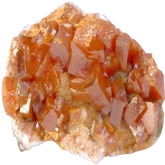Rock, Mineral, Crystal, or Gemstone?
 Rocks and minerals are all around us and used every day, perhaps without us even being aware of them. Besides making up the solid, supporting surface of the earth we live and move upon daily, rocks and minerals are used in surfacing roads, in the concrete foundations of our homes, in the brick and mortar of buildings, in clocks, and for scientific and industrial purposes. Soil consists primarily of small pieces of rocks and minerals. Metals used in our automobiles, buildings, and tin cans come from rocks. People’s interest in and use of these natural materials has led to a need to better understand, classify, and locate certain rocks and minerals.
Rocks and minerals are all around us and used every day, perhaps without us even being aware of them. Besides making up the solid, supporting surface of the earth we live and move upon daily, rocks and minerals are used in surfacing roads, in the concrete foundations of our homes, in the brick and mortar of buildings, in clocks, and for scientific and industrial purposes. Soil consists primarily of small pieces of rocks and minerals. Metals used in our automobiles, buildings, and tin cans come from rocks. People’s interest in and use of these natural materials has led to a need to better understand, classify, and locate certain rocks and minerals.
Rocks are solid, naturally occurring mixtures of substances, primarily minerals. Occasionally a rock may consist of a single mineral such as quartzite (pure quartz) or marble (pure calcite). A mineral is generally defined as a naturally occurring, inorganic (not from a living organism) solid with a definable chemical composition. A mineral may consist of a single element (such as sulfur or gold), though most are chemical compounds. Only eight elements make up nearly 99 percent of the minerals of earth’s crust. Oxygen makes up 46.8% of the crust, silicon 27.8%, aluminum 8.2%, iron 5.0%, calcium 3.6%, sodium 2.8%, potassium 2.6%, and magnesium 2.1%. Silicate minerals - those formed of silicon-oxygen compounds - are found in most common rocks.
It is the chemical make-up of a mineral which gives it its distinct properties. The types of atoms and how they are arranged and chemically bonded determine the color, shape, strength, hardness, or other properties of a mineral. The cleavage - the way a mineral breaks along planes - helps us identify it, as do its optical properties, its specific gravity, or special properties such as magnetism. Almost all minerals form crystals, generally as they cool and solidify from a melt or precipitate from solution. A crystal is a mineral with a regular, repeating geometric arrangement of atoms that gives the crystal flat faces formed at certain angles to each other. No two crystals are alike since their development depends upon available space as well as the temperature and pressure during their formation. A crystal can be distorted if not enough space is available as it forms. Gems are cut from gemstones, which are nicely formed crystals that are valued for their beauty and rarity.
About the Author
Claire-Jean Korzenewski, BS
 Claire-Jean Korzenewski has a B.S. in geology and experience in petroleum exploration. She is an educator with public school teaching experience in junior high and high school sciences. Claire-Jean is now a freelance writer who makes communications more effective - to inform, to educate, and to enhance profits for businesses and individuals.
Claire-Jean Korzenewski has a B.S. in geology and experience in petroleum exploration. She is an educator with public school teaching experience in junior high and high school sciences. Claire-Jean is now a freelance writer who makes communications more effective - to inform, to educate, and to enhance profits for businesses and individuals.


